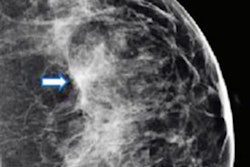
CHICAGO - Using ultrasound first can be cost-effective in evaluating non-calcified breast lesions from screening digital breast tomosynthesis (DBT), according to research presented November 29 at the RSNA annual meeting.
Dr. Berat Bersu Ozcan from the University of Texas Southwestern Medical Center in Dallas presented her team's results, which showed that an ultrasound-first approach yielded an incremental cost of $13 per 0.003 quality-adjusted life years yielded favorable cost-effectiveness ratios.
"The hope is that our study may provide much-needed evidence to help change clinical practices to reduce unnecessary diagnostic mammograms, while also improving patient experiences, optimizing workflows, and decreasing radiation," Ozcan told AuntMinnie.com.
With the growing popularity of DBT, the role of diagnostic mammography in looking at recalled lesions from screening DBT is being re-evaluated. One study Ozcan cited showed that 71.2% of recalled noncalcified lesions from screening DBT were "adequately" worked up via ultrasound.
Ozcan and colleagues wanted to look at the cost-effectiveness of using ultrasound rather than diagnostic mammography first in evaluating recalled lesions from screening DBT. They looked at these two modalities from a federal payer perspective with a one-year horizon.
Cost estimates were based on 2022 Medicare reimbursement rates for the researchers' respective university hospital. They also used a standard willingness to pay threshold of $10,000 per quality-adjusted life years (QALY) gained.
In the base case scenario, using ultrasound first led to a cost of $459 and 0.986 QALYs gained. In comparison, using diagnostic mammography first led to a cost of $446 and 0.983 QALYs gained.
"The change in quality of life may seem small here, but this is per patient," Ozcan said. "When you consider the total population, clinical impact can be significant."
She added that while the higher cost seen in the ultrasound-first strategy was surprising, she said this may be due to ultrasound leading to more biopsies than the mammography approach in the study.
Also, the researchers found that using ultrasound first yielded an incremental net monetary benefit of $277.98, with an incremental cost-effectiveness ratio of $4,400.71 per QALY.
In two-way sensitivity analysis, the researchers additionally found that the ultrasound-first approach was the better strategy in "any probable combination," having a higher net monetary benefit than the mammography approach. Ultrasound-first also had higher net monetary benefit than mammography first in one-way sensitivity analysis.
Monte Carlo simulations also showed that ultrasound was the more cost-effective strategy in 72.5% of iterations when a $10,000 per QALY threshold was in place.
Ozcan told AuntMinnie.com that the team is looking at "many" different areas related to this study to improve their cost-effectiveness model.
Ozcan was also given an RSNA member-in-training award for "Outstanding RSNA Presentation in Diagnostic Radiology."




















